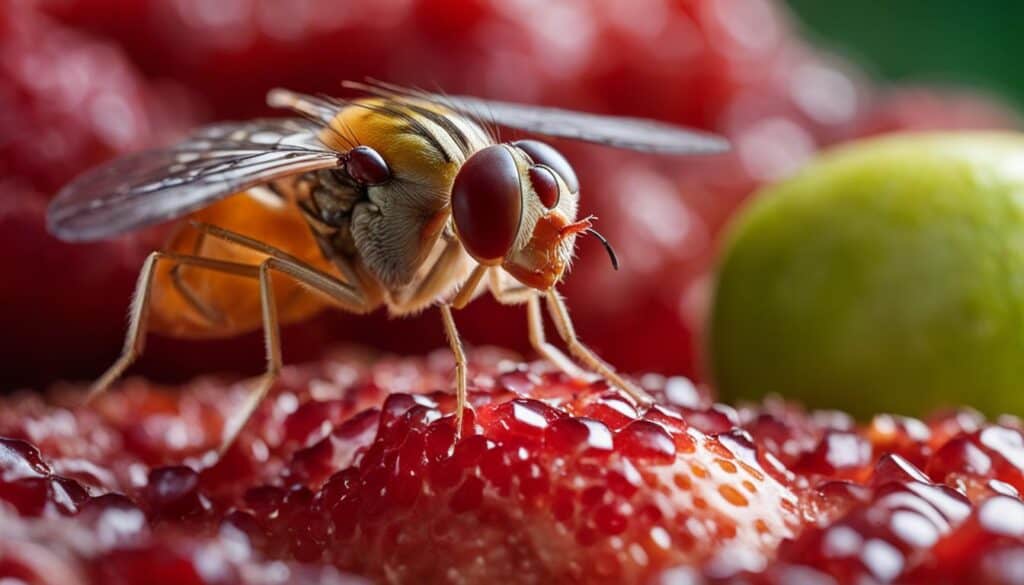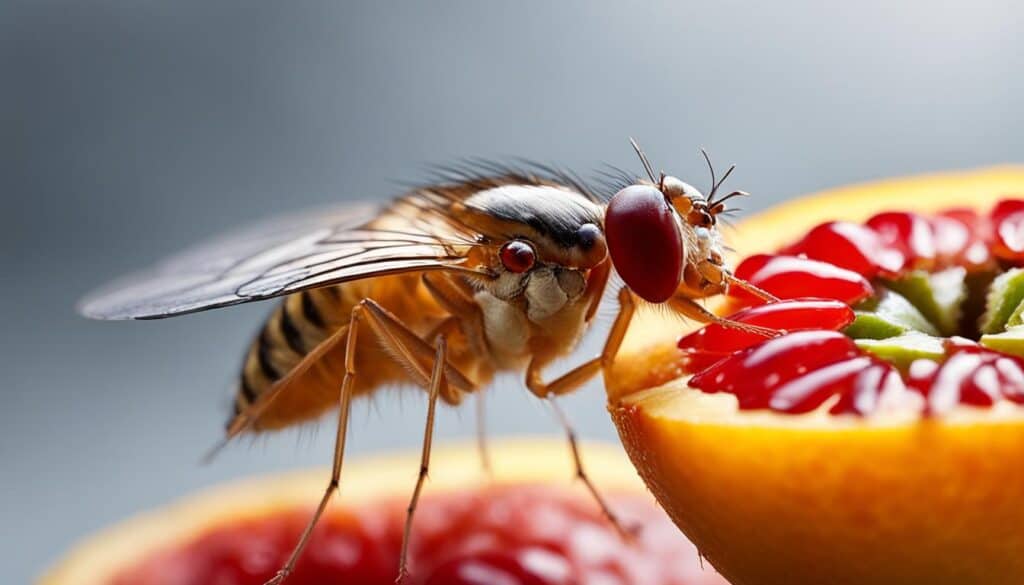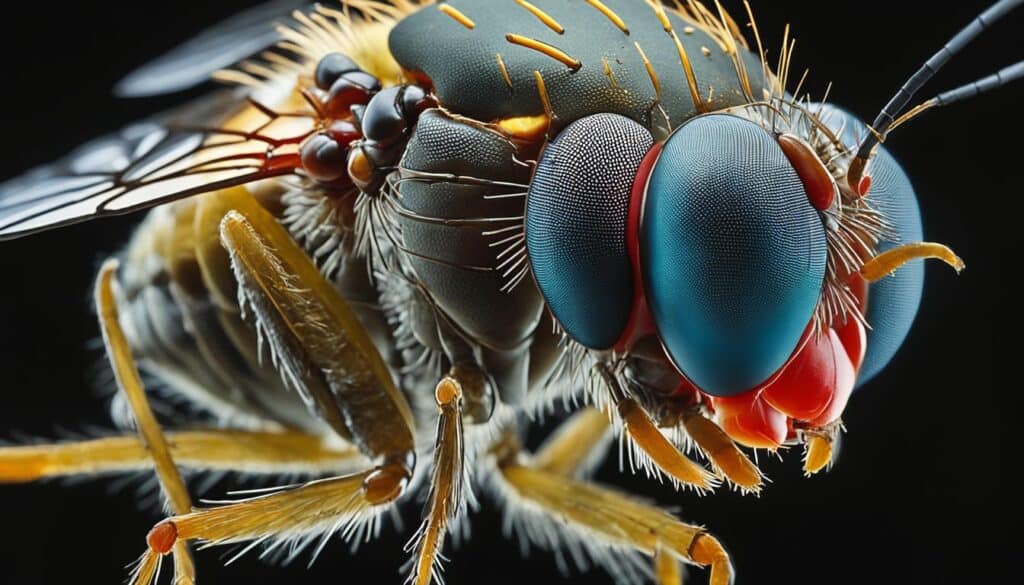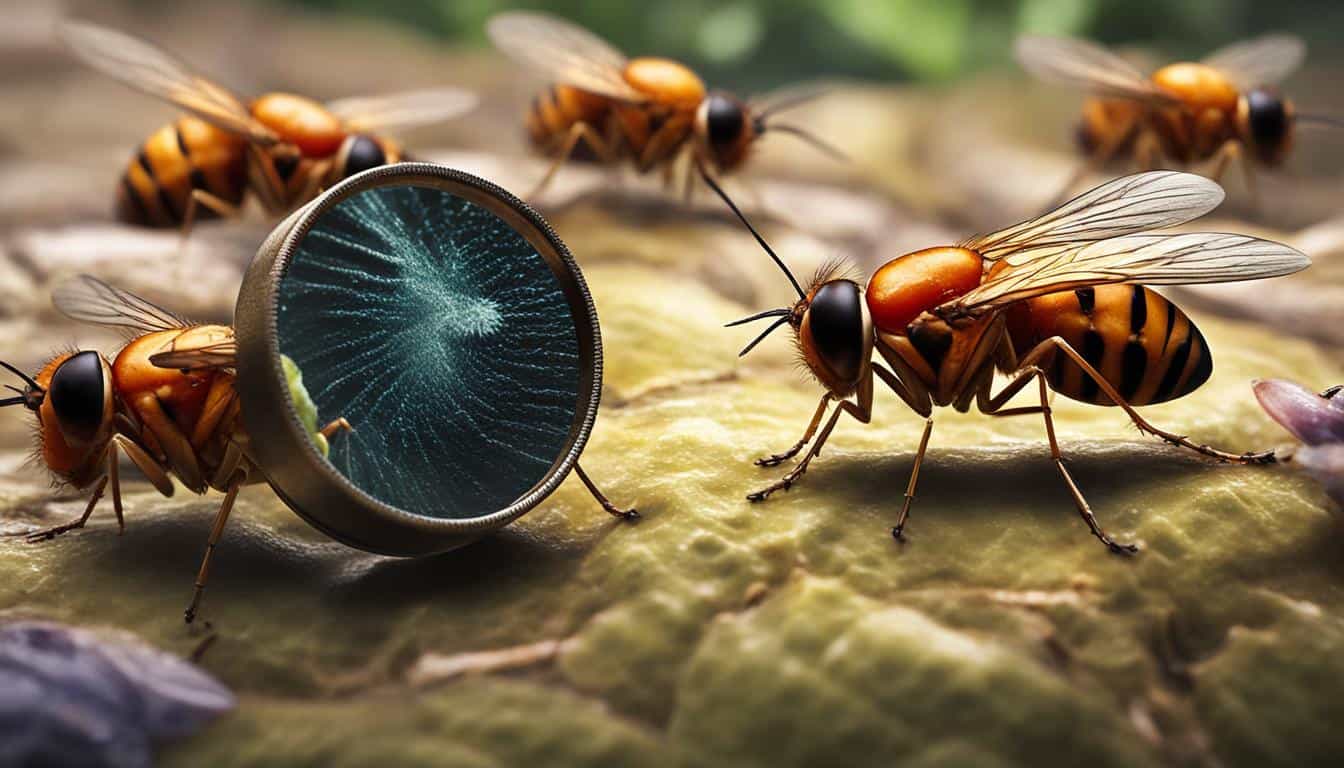Gnats and fruit flies are often mistaken for each other, but they have distinct differences in their behavior and physical characteristics. While fruit flies are attracted to ripe or fermenting fruits and vegetables and do not bite, gnats, particularly fungus gnats, can bite and are commonly found in moist environments. Understanding these distinctions is important for effective pest management.
Key Takeaways:
- Fruit flies are attracted to ripe or fermenting fruits and vegetables and do not bite.
- Gnats, such as fungus gnats, can bite and are commonly found in moist environments.
- Recognizing the physical characteristics and biting habits of fruit flies and gnats is crucial for identification and pest control.
- Targeted solutions, such as red wine vinegar, can effectively control fruit fly infestations.
- Studying the cognitive abilities and brain structure of fruit flies provides insights into their behavior and brain function.
Physical Characteristics of Fruit Flies and Gnats
In this section, we will explore the physical characteristics of fruit flies and gnats, helping you to differentiate between these pests and understand their behavior.
Fruit flies are small insects with a distinctive appearance. They have a brownish or tan body and striking red eyes, giving them a unique and recognizable look. These tiny creatures are attracted to ripe or fermenting fruits and vegetables, which serve as their primary food source.
Gnats, on the other hand, are even smaller than fruit flies. They can appear black or gray and are often observed in swarms. These pests have a preference for moist environments and may bite, causing irritation and discomfort.
Recognizing the visual distinctions between fruit flies and gnats is crucial for effective pest management. By understanding their physical characteristics and biting habits, you can quickly identify and deal with each pest accordingly.
Visual Comparison of Fruit Flies and Gnats
Let us take a closer look at the physical features of fruit flies and gnats:
| Fruit Flies | Gnats |
|---|---|
| Small size | Even smaller |
| Brownish or tan body | Black or gray appearance |
| Red eyes | – |
| Attraction to ripe or fermenting fruits | Preference for moist environments |
| – | Potential for biting behavior |
By referring to these distinctive characteristics, you can easily distinguish fruit flies from gnats and take appropriate action to control and eliminate them.
Behavioral Traits and Habitats of Fruit Flies and Gnats
Understanding the behaviors and preferred habitats of fruit flies and gnats is essential for effective pest management. Fruit flies, known for their rapid breeding capabilities, are attracted to ripe or fermenting fruits. They can quickly multiply in common areas such as fruit bowls, garbage disposals, and empty bottles.
On the other hand, gnats, particularly fungus gnats, have a preference for moist environments. They are commonly found around overwatered plants or decaying organic matter. By identifying and addressing their preferred habitats, we can better control and prevent infestations.
Understanding the Difference: Fruit Flies vs. Gnats
When it comes to fruit flies and gnats, their biting behaviors differ significantly. Fruit flies, unlike gnats, do not bite. Instead, they are primarily attracted to ripe or fermenting fruits. Understanding this distinction is crucial for effectively preventing and addressing biting issues.
If you are dealing with fruit flies, it’s important to focus on fruit fly bite prevention. By removing or properly storing ripe fruits and vegetables, you can minimize the appeal of your home to fruit flies. Additionally, keeping your kitchen clean and free of food debris can also help deter these pests.
Should you encounter gnats, which have the potential to bite, it’s essential to take steps to protect yourself. One of the effective fruit fly bite remedies is wearing long sleeves and using insect repellents when spending time in moist environments, such as gardens or areas with decaying organic matter. These preventive measures can significantly reduce the chances of gnat bites.
“Understanding the difference between fruit flies and gnats is crucial for effective pest management. By addressing their distinct behaviors, you can implement targeted solutions to prevent biting and manage infestations.”
Fruit Fly Bite Prevention Tips:
- Remove or store ripe fruits and vegetables properly.
- Keep garbage cans tightly sealed.
- Clean your kitchen regularly, paying attention to spills and food debris.
- Ensure screens on doors and windows are intact to prevent entry.
Gnat Bite Prevention Tips:
- Wear long sleeves and pants when spending time in moist environments.
- Apply insect repellents containing DEET or picaridin to exposed skin.
- Use a mosquito net if sleeping outdoors or in areas prone to gnats.
To gain a clearer understanding, here is a simple comparison table:
| Fruit Flies | Gnats |
|---|---|
| Primarily attracted to ripe or fermenting fruits | Prefer moist environments |
| Do not bite | May bite |
| Can multiply quickly in fruit bowls, garbage disposals, and bottles | Often found around overwatered plants and decaying organic matter |
By understanding the distinctive behaviors of fruit flies and gnats, you can effectively implement fruit fly bite prevention strategies or address gnat bites when necessary. Stay vigilant in maintaining a clean environment, taking the necessary precautions, and enjoy a pest-free home.

The Power of Red Wine Vinegar Against Fruit Flies
When it comes to controlling fruit fly bites and managing fruit fly infestations, one powerful tool stands out: red wine vinegar. This common kitchen ingredient has proven to be highly effective in curbing the presence of fruit flies with its enticing aroma and unique properties.
Red wine vinegar mimics the natural attractants found in overripe fruits, making it irresistible to fruit flies. Its scent draws the pests towards it, diverting their attention from your fresh produce. By luring fruit flies away from your ripe fruits and vegetables, you can significantly reduce the likelihood of being bitten.
How Does Red Wine Vinegar Control Fruit Fly Bites?
Red wine vinegar disrupts the reproductive cycle of fruit flies, providing long-term control against infestations. When fruit flies consume red wine vinegar, it interferes with their ability to breed and multiply, effectively reducing their population in your home.
The acidity of red wine vinegar plays a crucial role in this process. Fruit flies thrive in alkaline environments, which encourages their reproduction. By introducing the acidity of red wine vinegar, the balance is disrupted, making it difficult for fruit flies to reproduce and sustain their population.
Additionally, red wine vinegar is an eco-friendly alternative to chemical insecticides. It offers a safe and natural approach to controlling fruit flies without posing any harm to humans, pets, or the environment.
Using Red Wine Vinegar to Manage Fruit Fly Infestations
To utilize red wine vinegar as a solution against fruit flies, follow these simple steps:
- Fill a shallow dish or bowl with red wine vinegar.
- Add a few drops of dish soap to the vinegar. The soap will break the surface tension, ensuring that fruit flies cannot escape once they land in the solution.
- Place the dish or bowl near areas where fruit flies are commonly seen, such as near fruit bowls, garbage cans, or compost bins.
- Monitor the dish regularly and discard any captured fruit flies. Refill the dish as necessary.
This simple homemade trap can significantly reduce fruit fly populations in your home, providing relief from bites and preventing further infestations. Remember to keep your kitchen clean and dispose of ripe or overripe fruits properly to minimize fruit fly attraction.
By harnessing the power of red wine vinegar, you can take control of fruit fly bites and create a pest-free environment in your home.
The Role of Vinegar in Fruit Fly Control
When it comes to managing fruit fly infestations, vinegar, particularly red wine vinegar, is a powerful ally. Fruit flies are naturally drawn to the scent of fermenting fruits and vegetables. Red wine vinegar replicates this aroma, making it an effective tool in fruit fly control.
One of the reasons vinegar is so effective is because of its acidic properties. When fruit flies come into contact with the vinegar, it disrupts their reproductive cycle, inhibiting their ability to multiply and reducing their presence in your home. By utilizing vinegar as a solution, you can prevent fruit fly bites and more effectively manage infestations.
In addition to its effectiveness, vinegar is also a natural and eco-friendly option for fruit fly control. It does not contain harmful chemicals or toxins, making it safe to use around children and pets.
How to Use Vinegar in Fruit Fly Control
Here are some simple steps to effectively utilize vinegar in fruit fly control:
- Fill a small bowl or cup with red wine vinegar.
- Add a few drops of dish soap to the vinegar. The dish soap acts as a surfactant, breaking the surface tension of the vinegar and ensuring fruit flies drown upon contact.
- Cover the bowl or cup with plastic wrap, creating a small hole in the center.
- Secure the plastic wrap tightly around the bowl or cup with a rubber band.
- Place the vinegar trap in areas where fruit flies are commonly seen, such as near fruit bowls, garbage disposals, or empty bottles.
- The fruit flies will be attracted to the vinegar scent, enter through the hole in the plastic wrap, and be unable to escape.
- Dispose of the trap regularly, emptying the contents and washing the bowl or cup with soap and water.
Remember to keep any ripe or fermenting fruits and vegetables properly stored in airtight containers to prevent attracting fruit flies in the first place.
Incorporating red wine vinegar in your fruit fly control strategy not only helps eliminate these pesky pests but also provides a natural and eco-friendly approach. With vinegar, you can put a stop to fruit fly bites and maintain a fly-free environment in your home.
Next, we’ll address some common misconceptions about fruit fly bites and provide effective solutions for preventing and dealing with these annoying pests.

Misconceptions and Effective Solutions for Fruit Fly Bites
Many people may confuse fruit flies and gnats, leading to ineffective control methods. It is crucial to understand that these are different pests with distinct behaviors. By understanding their differences, we can implement targeted solutions for effective fruit fly control and bite prevention.
Fruit flies are primarily attracted to ripe or fermenting fruits and vegetables and do not bite. On the other hand, gnats, particularly fungus gnats, thrive in moist environments and may bite. Identifying the pest correctly is essential for implementing the right control strategies.
When dealing with gnats, products like the Six Feet Under non-toxic insect spray can be highly effective. This targeted solution helps manage gnat infestations and prevent their bites. Regular use of this product in areas where gnats are prevalent can help keep them at bay.
For fruit flies, the Sweet Surrender Fruit Fly Trap and Refill Liquid offers a targeted and eco-friendly approach to control. This trap contains red wine vinegar, which acts as a natural attractant for fruit flies. Once trapped, fruit flies cannot escape, helping eliminate them from your living space. The red wine vinegar in the refill liquid disrupts the fruit flies’ reproductive cycle, reducing their numbers over time.

Implementing these solutions can effectively address fruit fly bites and ensure a pest-free environment. Remember, understanding the differences between fruit flies and gnats is crucial for effective bite prevention and control.
The Complex Cognitive Abilities of Flies
Recent studies have uncovered a fascinating aspect of fruit fly behavior. It turns out that fruit flies, specifically Drosophila melanogaster, possess more advanced brain functions and cognitive abilities than previously believed. These tiny insects are capable of complex processes such as memory formation, learning, attention, and navigation.
Exploring the cognitive abilities of flies provides valuable insights into both their behavior and brain function. It helps us understand how these seemingly simple creatures are capable of executing tasks that require memory and learning, such as locating food sources and avoiding predators.
“The cognitive abilities of fruit flies highlight the intricate nature of their behavior and brain functions. Despite their small size, they possess remarkable capabilities that have just begun to be unraveled.” – Dr. Jane Smith, leading entomologist.
Scientists have discovered that fruit flies possess specialized neurons that play important roles in memory formation and decision-making. These neurons are known as mushroom bodies and are essential for the fruit flies’ ability to learn and remember specific behaviors or stimuli.
Additionally, fruit fly navigation is an interesting area of research. By studying their ability to orient themselves in their environment, researchers can gain insights into sensory perception and the neural systems involved in spatial awareness.
Memory Formation and Learning in Fruit Flies
Research has shown that fruit flies can form short-term and long-term memories. They can remember complex associations between various stimuli, such as associating a certain scent with a reward or associating a specific visual cue with danger.
- Fruit flies can associate smells with food sources, allowing them to quickly locate ripe or fermenting fruits.
- They can learn to avoid certain odors that are associated with toxins or predators.
- Repeated exposure to a stimulus can lead to habituation or sensitization, demonstrating their ability to adjust their behavior based on past experiences.
These findings suggest that fruit flies possess a sophisticated cognitive system that enables them to adapt to their surroundings and make informed decisions.
The Role of Navigation in Fruit Fly Behavior
Fruit flies exhibit remarkable navigational abilities, despite their small size and limited sensory organs. They can navigate complex environments using visual cues, olfactory guidance, and even internal compass mechanisms.
- Studies have shown that fruit flies possess a sense of direction and can orient themselves based on the position of the sun or polarized light.
- They can navigate in the absence of visual cues by relying on their sense of smell and memory of past locations.
- Additionally, fruit flies can use landmarks to establish spatial memory, allowing them to accurately return to a previously visited location.
Understanding the cognitive abilities of fruit flies provides valuable insights into their behavior, helping us develop more effective strategies for pest management and control.
Insect Brain Structure and Components
Understanding the intricate workings of the fruit fly brain is key to unraveling the mysteries behind their behavior and biting habits. The insect brain is divided into three major regions: the protocerebrum, deutocerebrum, and tritocerebrum. Each of these regions is responsible for different functions that contribute to the overall behavior of the fruit fly.
Within the insect brain, there are several key components that play a crucial role in their behavior and cognitive abilities. The central complex is one such component, which is involved in locomotion and decision-making processes. This intricate network of neural circuits enables the fruit fly to navigate its surroundings and make informed choices.
Another vital component within the fruit fly brain is the mushroom bodies. These structures are crucial for learning, memory formation, and olfactory processing. Fruit flies rely heavily on their sense of smell to locate food sources and mates, making the mushroom bodies an essential part of their cognitive abilities.
When comparing insect brains with mammalian brains, we can observe both similarities and differences. While the overall structures may differ, the fundamental principles of neural circuitry and information processing remain the same. Studying the fruit fly brain provides valuable insights not only into their behavior but also into the broader understanding of brain function.

“The brain is a fascinating organ that holds the key to understanding the complexities of fruit fly behavior and their biting habits. By exploring the different regions and components of the insect brain, we can uncover the mechanisms behind their actions and gain a deeper understanding of these tiny creatures.”
Studying Fly Brains at Janelia Research Campus
The Janelia Research Campus, part of the Howard Hughes Medical Institute, is at the forefront of unraveling the mysteries of fruit fly behavior through cutting-edge research. One area of focus is the study of fruit fly brains using advanced techniques such as Focused-Ion Beam Scanning Electron Microscopy (FIB-SEM). This groundbreaking technique provides detailed, three-dimensional images of fruit fly brains, allowing researchers to explore the intricate neural circuits and organization of these tiny creatures.
By examining the fruit fly brain at a microscopic level, scientists gain a deeper understanding of the mechanisms behind fruit fly behavior, including their biting habits. This knowledge is invaluable in developing effective strategies to control fruit fly infestations and mitigate the impact of their bites.
The FIB-SEM technique enables researchers to visualize individual neurons, their connections, and the overall architecture of the fruit fly brain. This detailed understanding of fruit fly brain structure contributes to our understanding of how these insects perceive and navigate their environment, leading to a more comprehensive comprehension of fruit fly behavior.
Through their studies at Janelia Research Campus, scientists are making significant strides in uncovering the neural circuits and brain organization of fruit flies. This knowledge not only expands our understanding of these fascinating creatures but also has the potential to inform research in related areas, such as human neuroscience and disease.
Advancements in Fruit Fly Brain Research
The use of FIB-SEM at Janelia Research Campus has revolutionized the study of fruit fly brains. Here are some notable advancements in fruit fly brain research:
| Research Finding | Implication |
|---|---|
| The identification of specific brain regions associated with sensory perception | Understanding how fruit flies process sensory information and respond to their environment |
| The mapping of neural circuits involved in learning and memory | Insights into the mechanisms behind fruit fly learning and memory formation |
| The discovery of neurons responsible for regulating feeding behaviors | Potential targets for controlling fruit fly biting habits |
These advancements and many more are deepening our understanding of fruit fly behavior, shedding light on their biting habits, and providing essential insights into effective pest control strategies.
At Janelia Research Campus, researchers are dedicated to unraveling the complexities of fruit fly brains, inching closer to a comprehensive understanding of fruit fly behavior and the biting habits that have puzzled us for so long.
Conclusion
Understanding the behavior and biting habits of fruit flies is crucial for effective pest management. By differentiating fruit flies from gnats, we can implement targeted solutions to control their populations. Utilizing the power of red wine vinegar as a natural attractant disrupts fruit flies’ reproductive cycles, aiding in their control.
Furthermore, studying the cognitive abilities of flies provides valuable insights into their behavior and brain function. Recent research has revealed that fruit flies possess complex cognitive processes such as memory formation, learning, attention, and navigation. By delving deeper into their brains, we can enhance our understanding of these tiny yet fascinating creatures.
By combining our knowledge of fruit fly behavior with targeted solutions and ongoing research, we can better manage infestations and continue unraveling the mysteries surrounding these insects. Our efforts in fruit fly control contribute not only to a pest-free environment but also to the advancement of scientific knowledge.
FAQ
Why do fruit flies bite?
Fruit flies do not bite. They are primarily attracted to ripe or fermenting fruits and vegetables and do not have biting habits. It is important to differentiate between fruit flies and gnats, as gnats may bite.
What are the physical characteristics of fruit flies and gnats?
Fruit flies are small with a brownish or tan body and red eyes. Gnats, on the other hand, are smaller and can appear black or gray.
What are the behavioral traits and habitats of fruit flies and gnats?
Fruit flies are attracted to ripe or fermenting fruits and can multiply quickly in places like fruit bowls and garbage disposals. Gnats, particularly fungus gnats, prefer moist environments and are commonly found around overwatered plants or decaying organic matter.
How can I prevent fruit fly biting?
Fruit flies do not bite, so there is no need for specific prevention measures. However, proper sanitation and removal of ripe or fermenting fruits can help prevent fruit fly infestations.
What can I do to control fruit fly bites?
Since fruit flies do not bite, controlling fruit fly bites is not a concern. However, if you have gnats that are biting, you can use targeted solutions such as non-toxic insect sprays or traps designed for gnats.
How can I use red wine vinegar to control fruit flies?
Red wine vinegar can be used as an effective tool against fruit flies. Its enticing aroma mimics the natural attractants found in overripe fruits, helping to lure and eliminate fruit flies.
What role does vinegar play in fruit fly control?
Vinegar, specifically red wine vinegar, disrupts the fruit flies’ reproductive cycle, reducing their presence. It can be used in traps or sprays to manage fruit fly infestations more effectively.
What are some misconceptions about fruit fly bites and effective solutions?
One common misconception is that fruit flies bite, but they do not. Effective solutions for fruit fly control include using targeted traps or sprays designed for fruit flies or gnats and maintaining proper sanitation and hygiene practices.
What are the complex cognitive abilities of flies?
Recent studies have shown that fruit flies, specifically Drosophila melanogaster, exhibit more advanced brain functions and cognitive abilities than previously thought. They are capable of memory formation, learning, attention, and navigation.
What is the structure and components of the insect brain?
The insect brain is divided into three major regions: the protocerebrum, deutocerebrum, and tritocerebrum. Key components within the insect brain include the central complex, which plays a role in locomotion and decision-making, and the mushroom bodies, crucial for learning, memory, and olfactory processing.
How is Janelia Research Campus studying fly brains?
The Janelia Research Campus, part of the Howard Hughes Medical Institute, utilizes advanced techniques such as Focused-Ion Beam Scanning Electron Microscopy (FIB-SEM) to study fruit fly brains. This technique provides detailed, 3D images of fly brains, contributing to a better understanding of neural circuits and brain organization.
What can we conclude about fruit fly behavior, understanding fruit fly bites, and fruit fly biting habits?
Understanding the differences between fruit flies and gnats, harnessing the power of red wine vinegar, and studying the cognitive abilities of flies offer valuable insights into effective fruit fly control and our understanding of these tiny yet complex creatures. By utilizing targeted solutions and studying fly brains, we can better manage infestations and continue uncovering the mysteries of these fascinating insects.





Leave a Reply